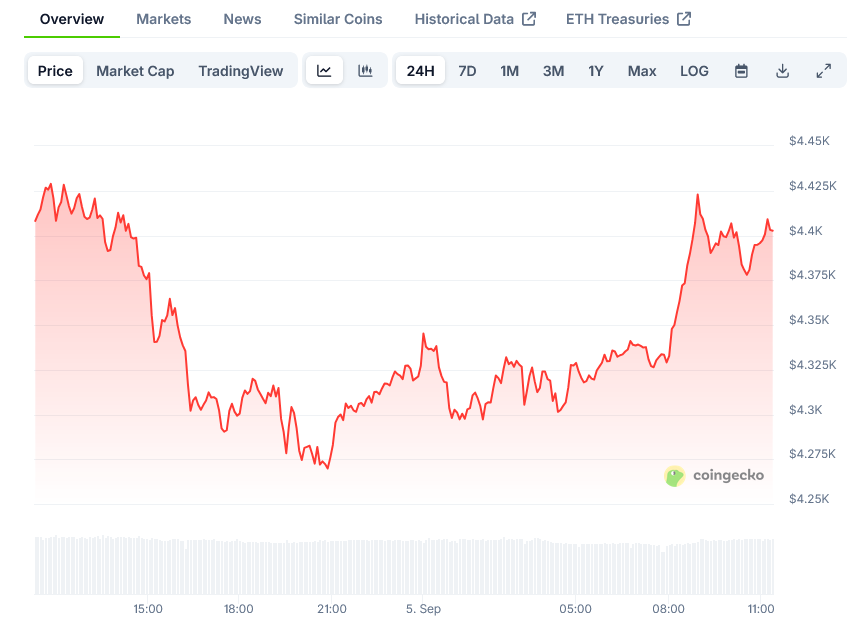Ethereum (ETH) Price: Staking, Tokenization, and Demographics Push Token Toward $10,000 Target

TLDR
- Ethereum’s price has surged to $4,400, up 83% in the past year
- Analysts predict ETH could reach $7,500 by year-end and potentially $10,000 or $20,000 in this cycle
- Nearly one-third of ETH’s total supply (36 million) is now staked, offering 2.9% APR
- Real-world asset tokenization on Ethereum has grown to $11 billion, part of a $24 billion market
- Over 50% of Gen Z owns crypto, with $100 trillion in wealth transfer expected over next two decades
Ethereum has awakened from its slumber and is showing strong upward momentum in the crypto market. After a period of underperformance compared to Bitcoin, XRP, and Solana, ETH has broken a new price record and is now trading at approximately $4,400, representing an 83% increase over the past year.
Market analysts are becoming increasingly bullish on Ethereum’s prospects. Some predict ETH will reach $7,500 by the end of the year, with more optimistic forecasts suggesting a potential $20,000 valuation during the current market cycle.
Samir Kerbage, chief investment officer at Hashdex, has identified Ethereum as crypto’s “sleeping giant” and now points to several converging factors that make it particularly attractive for long-term investors.
“One enduring lesson I’ve learned from navigating crypto markets over the last decade is that transformative ecosystem shifts often unfold during periods of apparent quiet,” Kerbage noted in a recent investor communication.
His confidence extends to a bold price prediction:
“My expectation is that ETH can surpass $10,000 once we start to see stablecoin solutions being implemented for US payments.”
Three main catalysts appear to be driving this positive outlook for Ethereum’s future growth and price appreciation.
Staking Drives Institutional Interest
The staking model has become a major attraction for yield-seeking investors. Nearly 36 million ETH tokens are currently staked, accounting for almost one-third of the network’s total supply, according to the Ethereum Foundation.
This staking mechanism offers an average 2.9% APR, making it appealing to yield-focused portfolios while simultaneously enhancing network security and reflecting growing investor confidence.
Jeff Park, head of Alpha Strategies at Bitwise, believes Ethereum presents a stronger corporate investment case than Bitcoin precisely because of this yield-generating capability.
“Investors will lean into Ethereum not just so that it can appreciate in price alone, but because someone is doing something with that to generate yield,” Park explained.
Institutional investors have already committed heavily to Ethereum, with ETFs now holding $24 billion worth of ETH. Some analysts project that large entities could eventually hold up to 10% of the total supply.
Real-World Asset Tokenization Accelerates
The tokenization of real-world assets (RWAs) on Ethereum has exceeded expectations, reaching $24 billion by mid-2025—a dramatic increase from just $5 billion in 2022.
Of this total market, Ethereum accounts for $11 billion of tokenized value, according to data from DefiLlama.
Bank of America has forecast that the RWA tokenization market could expand to $16 trillion over the next five to 15 years, though current growth rates suggest this timeline may be conservative.
BlackRock CEO Larry Fink, who described tokenization as a potential revolution in finance back in 2023, has maintained his optimistic stance. His firm’s tokenized fund, BUIDL, has emerged as the largest in the sector with $2.2 billion under management.
Kerbage also expects regulatory developments like the Genius Act to further stimulate growth in the stablecoin sector, which will benefit the Ethereum ecosystem.
Generational Wealth Transfer
Demographics are playing a crucial role in Ethereum’s growth story. Over 50% of Generation Z already owns cryptocurrency, and an estimated $100 trillion in wealth is expected to transfer from older generations to younger ones over the next two decades.
This shift mirrors previous technological adoption patterns, such as credit cards in the 1990s or the rise of the internet. While older demographics may remain skeptical, Ethereum’s practical utility has become undeniable after a decade of existence.
Ethereum’s price surge is further supported by fresh regulation surrounding stablecoins, the emergence of Ethereum treasuries, persistent buying pressure through exchange-traded funds, and rising staking yields.
As institutional adoption continues and the ecosystem expands, many analysts now view the $10,000 price target for ETH as achievable in the medium term, particularly as stablecoin payment solutions gain traction in the United States.
The post Ethereum (ETH) Price: Staking, Tokenization, and Demographics Push Token Toward $10,000 Target appeared first on Blockonomi.



